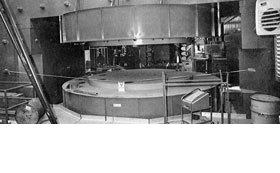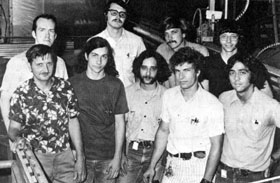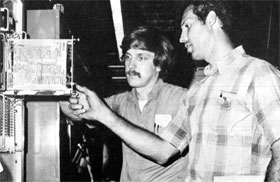Chicago Magnet Continues Particle Research at NAL
NAL's Neutrino Section is completing its refurbishing of the 2500-ton magnet brought to NAL in 1971 and 1972 from the University of Chicago. Once the world's largest particle accelerator, a synchrocyclotron with an energy of 450 million electron volts, the Chicago machine's life ended July 12, 1971. Within a few months it had been dismantled and the magnet from the machine began its journey by rail to NAL. The 53 pieces were re-assembled in the Muon Area of the NAL Neutrino line where the magnet served as a spectrometer to sort particles by momentum for experiments done there.
Gene Woods, NAL engineer who directed the magnet power supply installation, reported that the magnet was brought to a field of approximately 13.6 kilogauss at 3,800 amperes on June 21. A change was made to an SCR-controlled power supply instead of the original generator-driven power supply, and the magnet was reworked to have a wider gap.
The synchrocyclotron was an important facility at the University of Chicago and is referred to with affection by scientists who have used it. Many of the important original discoveries about subatomic particles were made by experimenters there. Among the people working there were Herbert L. Anderson and S. Courtenay Wright, professors in the Department of Physics and the Enrico Fermi Institute at Chicago. These two men and Luke Mo, assistant professor in the Department of Physics and the Fermi Institute, directed the University of Chicago portion of the first collaboration to use the magnet at NAL. Their installation also included massive steel blocks carved from the remains of a cyclotron built at the University of Rochester in the 1950's and discontinued about the same time as Chicago's.
A second generation of workers claimed the venerable piece of equipment, and it began what Dr. Wright referred to as "its phoenix," a second life emerged from the ashes of its first.
The work at NAL was under the direction of the NAL Neutrino Section headed by R. Orr, assisted by T. Toohig and W. Nestander. Installation of the coil was done by R. Rihel, Frank Mallie, Ross Doyle, R. McCracken and E. Laukant of Technical Services performed valuable liaison.
Electrical controls' installation and fabrication was handled by W. Williams, J. Walker, K. Roy, C. Worel, G. Ross, L. Beverly, and P. Burton of the Oxford Experimental Group.






